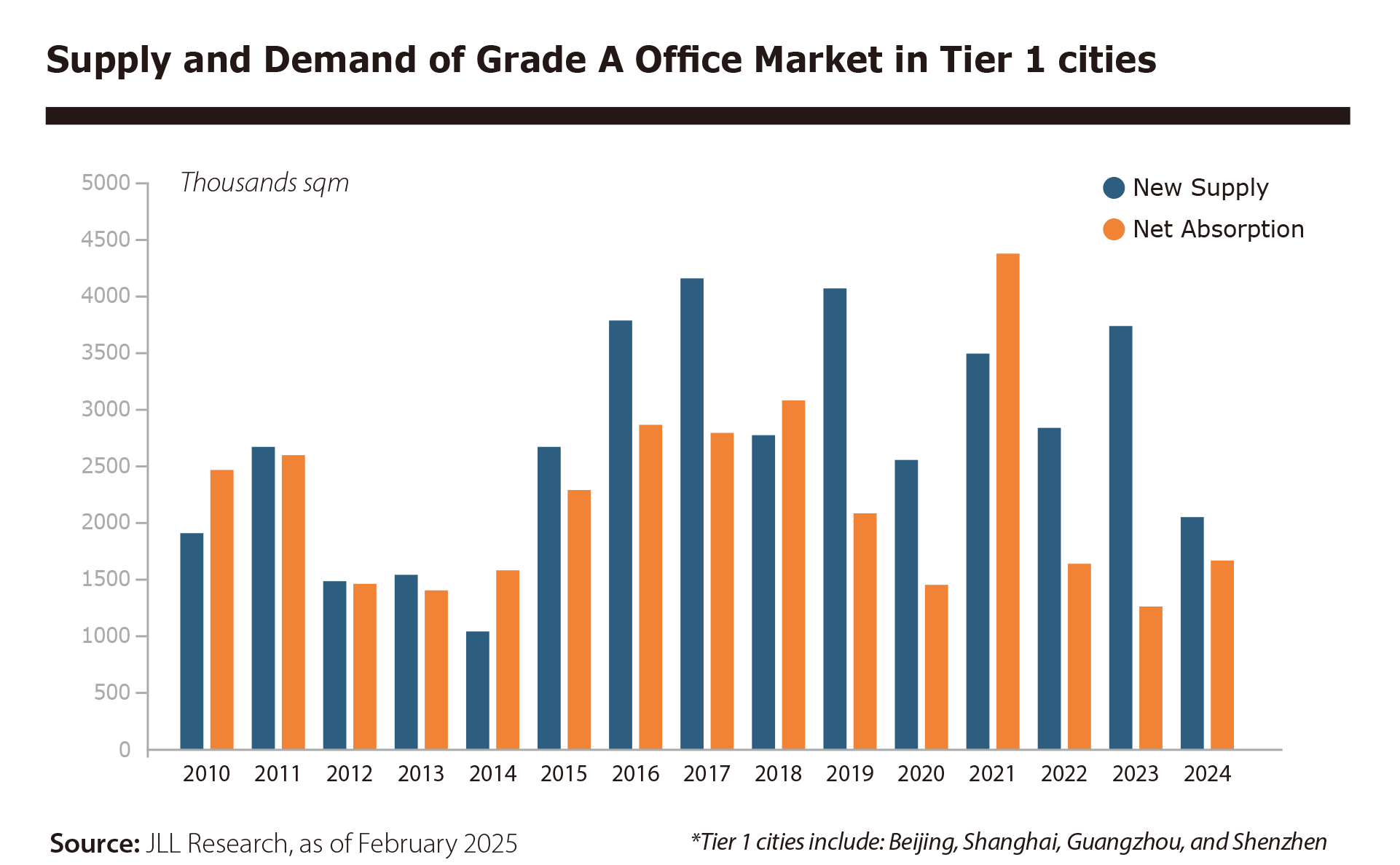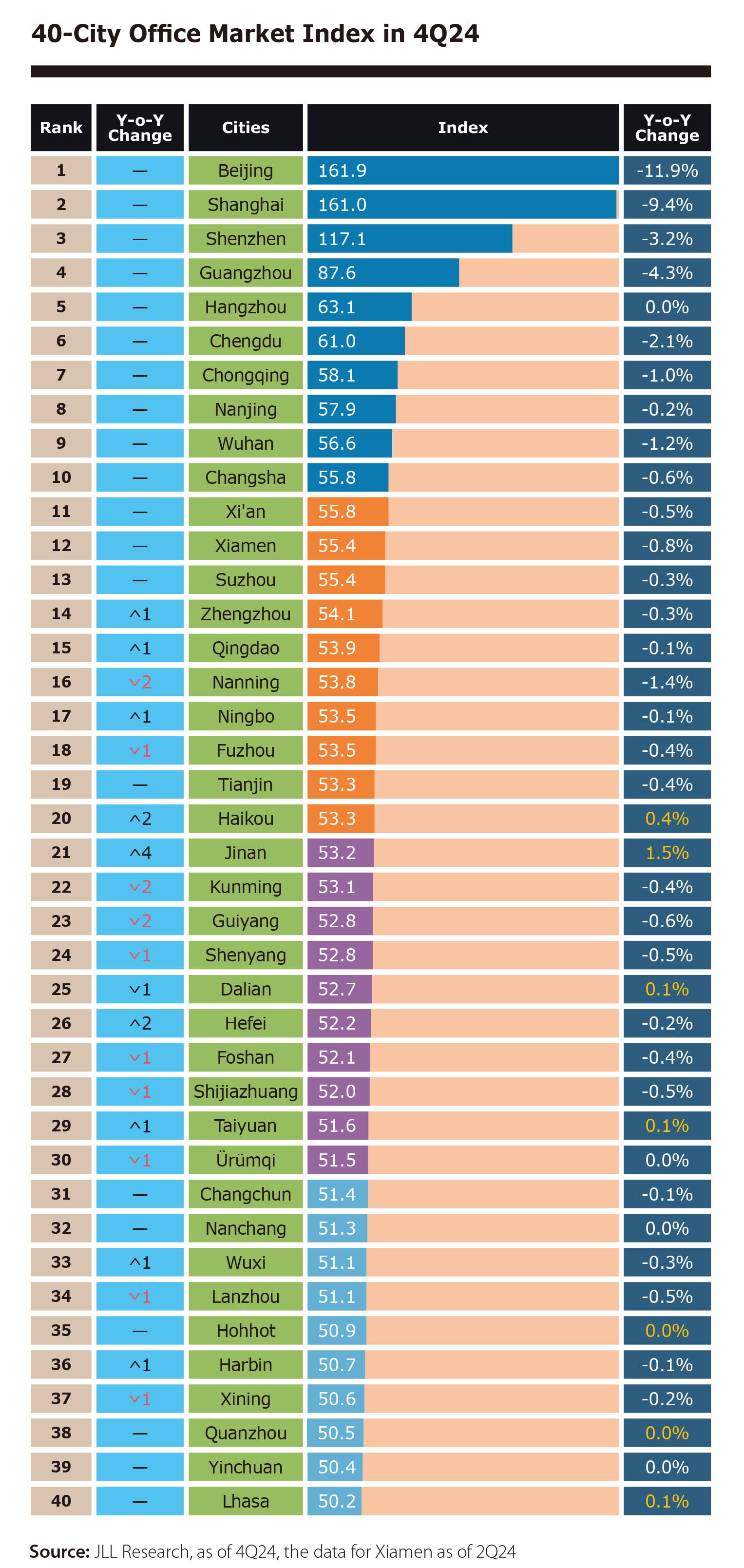The Future of China’s Office Sector: Costs, Competition, and Emerging Demand
By Daniel Yao
China’s office market is undergoing a period of transition, shaped by policy stimulus, evolving demand patterns, and supply pressures. In this exclusive analysis, Daniel Yao, Head of Research at JLL China, examines the key trends defining the Grade A office market across China’s major cities in 2024. With leasing demand shifting amid rental declines and economic headwinds, companies are capitalizing on cost-driven opportunities, while emerging industries show long-term growth potential. Will policy interventions and evolving corporate strategies drive a market rebound? Read on for expert insights into the future trajectory of China’s commercial real estate sector.

Depositphotos.com
In 2024, China’s economy made notable progress despite a shifting domestic and international landscape. With GDP growth reaching 5.0% year-on-year (y-o-y) and annual economic targets met, confidence in long-term stability and recovery has started to improve. A package of policy stimulus measures played a crucial role in achieving this growth. In the second half of 2024, the government introduced additional expansionary policies aimed at boosting the economy. However, the full impact of these policies is yet to be realized.
In the office market, leasing demand improved slightly, aided by rental declines and policy support. However, with continued pressure from high supply volumes, the market remains in a prolonged phase of bottoming out and recovery.
Cautious Sentiment but Select Opportunities
In 2024, the 20 key cities tracked by JLL recorded 3.9 million square meters (sqm) of newly completed Grade A office space, a 35.5% decrease compared to 2023. Despite this decline in new supply, market sentiment remained cautious, and expansion demand did not show significant growth. Total net absorption for these cities reached 2.5 million sqm, down 1.6% y-o-y, but still in line with the three-year average.
With declining rents and cautious sentiment, cost-driven demand remained a dominant factor in leasing activity. Landlords became increasingly flexible, offering rental discounts to attract new tenants.
For example, in Shanghai, rental adjustments created an opportunity for tenants to upgrade their offices at lower costs. Cost-sensitive occupiers were able to negotiate favorable leasing terms, allowing them to relocate or upgrade amid falling rents.

Industry-Specific Demand Drivers
Cornerstone industries continued to provide a stable foundation for Grade A office demand in China. Emerging “New Quality Productive Forces”—industries driven by rapid technological innovation—showed strong leasing potential.
Key demand trends included:
- Financial services and professional services remained the primary sources of leasing activity, especially in Tier-1 cities like Beijing and Shanghai.
- Self-use demand from state-owned enterprises (SOEs) and private conglomerates was resilient, helping to stabilize the market. In Shenzhen, Grade A office net absorption reached 880,000 sqm, with self-use demand accounting for nearly 60%. Similar trends were observed in Chengdu and Chongqing, where nearly all net take-up in 2024 was driven by corporate headquarters’ self-use demand.
While “New Quality Productive Forces” industries are still in their early stages, specific sectors—such as technology, media, and telecommunications (TMT)—are already demonstrating strong office demand. Artificial intelligence (AI)-focused companies saw a resurgence in leasing activity, particularly in Shanghai, Hangzhou, and Shenzhen.
With global economic uncertainties persisting, firms remained cautious about their corporate real estate (CRE) strategies, prioritizing cost-saving measures. With subdued demand and ample supply, most landlords across major cities further reduced rents to attract tenants.
As tenants adjusted their expectations downward, the rental decline accelerated in 2024. Among the 20 major cities, 19 experienced sharper rent declines compared to the previous year. Average rental declines ranged from -1.2% to -16.1%, with the overall decline rate accelerating by 2.7 percentage points y-o-y, the largest reduction in the past three years.

Market Trends by City Tier
Tier-1 Cities
Beijing’s Grade A office market remained on a downward trajectory, with rents declining 16.1% y-o-y. Facing intensified market competition, landlords reached a consensus to offer larger-scale rental concessions to retain tenants and maintain high occupancy rates. Various rental packages were designed to encourage or incentivize renewal agreements.
In Shanghai, rents declined 14.7% y-o-y, with landlords becoming increasingly flexible on both renewal and new leasing terms to maintain occupancy. In addition to traditional incentives such as longer rent-free periods or CapEx reimbursements, developers also introduced physical fit-out materials as part of lease negotiations.
Guangzhou experienced a slow demand recovery, with net absorption remaining in deficit. Landlords faced increasing pressure from high vacancy rates, leading to a 7.5% y-o-y decline in rental values.
In Shenzhen, rents continued to fall, with an annual decrease of 9.3%. Across all four Tier-1 cities, landlords struggled in 2024, forced to reduce rents and introduce additional incentives to compete with newly completed buildings.
Tier-1.5 and Tier-2 Cities
Rental reductions were even more commonly employed in Tier-1.5 and Tier-2 cities as landlords faced rising vacancy rates amid a high volume of new supply.
- Nanjing: Cost-saving strategies further compressed landlords’ bargaining positions. Toward the end of the year, landlords adopted more proactive leasing approaches, aiming to accelerate tenant decision-making and secure deals before year-end. As a result, Grade A office rents declined 7.1% y-o-y.
- Qingdao: Rents recorded a 6.6% y-o-y decline, as landlords sought to attract the limited pool of tenants through explicit price reductions and additional incentives, such as longer rent-free and fit-out periods. These strategies intensified market competition further.
Among the 10 cities ranked as top-tier, index fluctuations were primarily driven by rental movements. Highly developed cities experienced more significant impacts from rental adjustments, leading to larger index declines compared to the previous year.
- In Beijing, extremely low-priced leasing deals forced the market to reassess rental floors.
- In Shanghai, Shenzhen, and Guangzhou, while net absorption volumes remained relatively high, continued rental declines pressured the index.
- Hangzhou, on the other hand, demonstrated resilience, with stable rental values and steady leasing demand, keeping its index position largely unchanged.
In the short term, expansionary fiscal and monetary policies are expected to support sentiment improvement, potentially leading to a moderate recovery in leasing demand. However, supply pressures will persist, as major cities require more time to absorb existing vacancies and rebalance demand and supply.
Looking ahead, technological advancements and industry transformation will drive new demand. Emerging industries rooted in traditional sectors are expected to become key drivers of recovery, fueling long-term demand for office space.

This article is from the AmCham China Quarterly Magazine (Issue 1, 2025). To access the entire publication for free, sign up on our member portal here.

